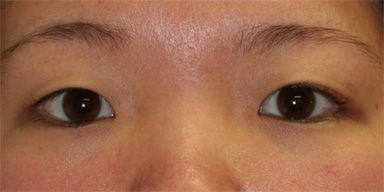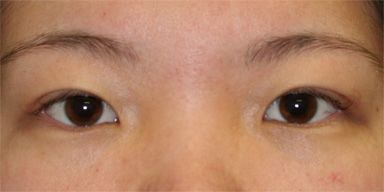Double Eyelid Surgery in Arcadia, CA
Conveniently located to serve Arcadia, CA
For patients who desire bigger, brighter eyes by placing (or replacing) a fold in their upper eyelids, double-eyelid surgery, also known as Asian eyelid surgery, can result in attractive eyes that have a natural appearance. In the past, this surgery has been improperly described as a “Westernization surgery.” And, in fact, Western surgeons often performed it as a Westernization surgery, with a very high fold created that appeared unnatural and awkward in the Asian eyelid. Since approximately 50% of East Asians are born with double eyelids, and because the contour, height, and anatomy of eyelid folds are different between Asians and Caucasians, the “Westernization label is improper and short-sighted. Multiple techniques are available for the creation of a double-eyelid, and the one best suited to your unique situation will be chosen.
In Caucasian eyes, there are specific attachments that lead from the skin along the eyelid fold down to the deeper tissues. In Asian eyes without a fold, there do not appear to be any such attachments. The key to Asian eyelid, or double-eyelid surgery is to create an attachment to form a crease that deepens into a fold when the eyelid opens (retracts upward). In some cases, adjustments can also be made to the skin covering in the inner corners of the eyes, which can make the eyes appear as though they are spread too far apart. Opening the eyes in this way makes them appear more harmonious with the rest of the face and larger.
Preparation
There are a variety of techniques for Asian eyelid, or double-eyelid surgery (Asian Blepharoplasty), and each has advantages and disadvantages. Dr. Jen Chow is familiar with several different techniques, including suture ligation methods and external incision methods, which are described below.
One popular set of double-eyelid surgery methods involves using suture ligation (stitches) with little or no incisions in the skin in order to create the double fold. In its simplest form, this can simply involve placing several (usually three) stiches through the various layers of the upper eyelids (skin, muscle, the “levator aponeurosis,” Müller’s muscle, and even a tiny amount of conjunctiva) to create the fold. Variations of this technique generally involve alterations in the type of suturing performed, the use of tiny incisions with suturing, and even the use of additional instruments specificially designed for eyelid suture placement. The advantages of the suture ligation method is that it is relatively non-invasive and has less swelling after the procedure. The main disadvantage is that the crease has a higher likelihood of disappearing with time. The disappearance rate is higher in those who have thicker eyelid skin or who have excess fat underneath the eyelid skin (and possibly muscle).
The other major category of double eyelid, or Asian eyelid (Asian blepharoplasty) techniques involves the use of an incision (or set of small incisions) in the upper eyelid during surgery. There is considerable variation within this set of techniques, allowing the surgeon to treat a wide variety of eyelids. Skin, muscle, and/or fat may be removed during the procedure in order to enhance the appearance of the eyelid. The skin may then be sutured to the levator aponeurosis or the upper tarsus in order to form a crease. The sutures used may be permanent and buried beneath the skin or removed after 5-7 days following surgery. One advantage of the incision techniques is that there appears to be more predictability and permanence with this approach, with a long-lasting crease that does not appear to fade over time. Of course, for those who have too much skin, muscle, or fat, these tissues can be trimmed during the procedure in order to provide a more pleasing final result. The main disadvantage of these techniques is that there is relatively more swelling and a higher probability of bruising after surgery as compared to suture ligation techniques.
In most cases, Dr. Chow prefers the incision technique, as he has found this method to result in more reliable, beautiful, long-lasting double eyelids. He is also able to adapt the procedure to a wide range of eyelids from individuals of different ages, ethnicities, gender, and cosmetic preferences. However, Dr. Chow will develop a plan specific to your aesthetic goals and concerns.
Before Your Eyelid Surgery
During your initial consultation and on any subsequent visits, Dr. Chow will perform a complete history and physical examination of your face and eyes to ensure that double-eyelid surgery will be as safe and effective as possible. He will take the time to discuss your cosmetic concerns and answer any questions you may have.
Before having any cosmetic surgery, you should always review the medications, supplements, vitamins, and foods that you consume. Many of these can cause problems during your procedure because they thin your blood, making you more likely to have heavier bruising or complicating the procedure with excessive bleeding. Others may overly enhance or otherwise interact with the numbing anesthetic used during your double eyelid surgery.
At the Chow Center, your full medical history will be reviewed, especially any eye conditions you may have, such as dry eyes. Use of eyeglasses, contacts, and eye medications should be recorded. For example, the use of contact lenses has been associated with the loss of double eyelids over time. If you are seeing an ophthalmologist, or eye doctor, for any reason, you will likely need to have this physician clear you for an Asian blepharoplasty prior to surgery. Previous surgeries, especially eyelid surgeries, must also be known, as they could affect your final outcome.
Day of Your Surgery
Please be sure to avoid the use of make-up on the day of surgery. Before the procedure begins, Dr. Chow will meet with you to discuss any last minute questions you may have. He may also take some measurements and occasionally make some markings while you are in the sitting position to aid in accurate fat removal during surgery.
In approximately two-thirds of his double-eyelid surgeries, Dr. Chow performs the double eyelid procedure at an outpatient surgery facility with an anesthesiologist, or doctor of anesthesia, present. This is because many patients prefer to be comfortably sedated during the procedure through the use of IV (intravenous) medications in addition to local anesthetic. In the other one-third of cases, patients prefer to be fairly awake, taking medication by mouth for relaxation and then undergoing the procedure after having their eyelids fully numbed by local anesthetic. This is a choice that you should make after having a thorough discussion with your facial plastic surgeon.
Once the procedure begins, you will have numbing eye drops placed, followed by thick contact lenses called corneal protectors in order to enhance safety. Your eyelids will be remeasured and marked, possibly a second time, before numbing local anesthetic is injected. Dr. Chow will then perform either a suture ligation or incision double eyelid blepharoplasty. You will be asked to open and close your eyes during the case, though your vision will be impaired by the corneal protectors. You will also be asked to look upwards from time to time. Once the procedure has been completed, your vision may be temporarily blurry from ointment.
You will have a period of recovery afterwards, while a nurse, or team of nurses, watch(es) over you with physician supervision.


* Individual results may vary.
Recovery Info
After Your Double-Eyelid Surgery (Asian Blepharoplasty)
You will receive an information packet prior to your surgery explaining what to do and what to expect after double eyelid, or Asian eyelid, surgery (Asian blepharoplasty). You will also have access to reach Dr. Chow after hours and during the weekends should any questions or concerns arise.
You will have medications to take after surgery, including an eye ointment, an antibiotic to prevent infection, and a pain medication. You may receive medication to reduce swelling as well. It is important to take the medications as prescribed. Feel free to contact the Chow Center if you are unsure about your medications at any time.
In general, you will have some mild to moderate swelling of your upper eyelids after the procedure. Although this usually does not affect your vision, the swelling can cause the crease to appear very high at first. As the swelling resolves, this initial appearance will resolve into a more natural, contoured result.
You will have a number of required follow up visits immediately after surgery. These visits enable Dr. Chow to see your progress as you recover. Patients are often seen the day after, three days after, and one week after surgery. Should you decide to have your double-eyelid surgery at the Chow Center, your actual follow up visits may vary depending on your unique circumstances.
FAQ
-
What is an “Asian eyelid?”
Asian eyelids, quite simply, are eyelids that belong to those of Asian descent. Most commonly, when discussing Asian eyelids, we are referring to those of East or Southeast Asian ancestry. Naturally, Asian eyelids are different from those of Caucasians. Approximately 50% of all East and Southeast Asians are born with “single eyelids,” which do not have a crease, or fold, in the upper eyelid. For the other 50% who do have this crease, their eyelids are called “double eyelids,” since the fold divides the eyelid into two parts.
-
Why is there a separate “Asian eyelid” surgery apart from normal upper eyelid surgery?
Many Asians who have single eyelids prefer the appearance of double eyelids, which appears to open the eye, making it look larger and more attractive. Among women, having a crease with a double eyelid can improve the appearance and ease the application of eye make-up.
-
If I already have double eyelids, can I still have Asian eyelid surgery (Asian blepharoplasty)?
Yes, in some cases, Asian eyelid surgery can be used to enhance to rejuvenate an eye that already has a crease. For example, the procedure may be used to remove excess skin, which has formed as the eyelid ages over time. It can also turn multiple creases into a single, streamlined, and more beautiful crease.
-
Where will my crease be placed? How high above my eyelashes will it be?
Although Dr. Jen Chow will work with you to determine the approximate height and shape of the crease, the exact height of the crease will depend on multiple factors, including just how you heal.
-
How old do I have to be in order to have Asian eyelid (double eyelid) surgery (Asian blepharoplasty)?
As a general rule, Dr. Chow will perform the procedure on those 18 years of age or older. In every case, Dr. Chow will first meet and examine you, taking a careful history and physical prior to determining your eligibility for this procedure.
-
What happens during an Asian eyelid, or double eyelid, surgery?
Please see the description of Asian blepharoplasty.
-
What surgical techniques does Dr. Chow use to form the double eyelid?
Please see the description of Asian blepharoplasty.
-
What happens after the procedure?
Please see the description of Asian blepharoplasty.
-
How long does double eyelid surgery take?
In most cases, Asian eyelid surgery takes approximately one hour, though the addition of preoperative sedation and postoperative recovery can extend this time by another hour. Dr. Chow will never rush your procedure in order to “keep it under an hour,” and instead focuses on providing the safest treatment to provide the most beautiful double eyelid possible.
-
Will it hurt?
During the procedure, most patients are sedated and very comfortable. The greatest discomfort is usually associated with the first application of numbing medication, after which most patients feel only gentle tugging and occasional pressure. After the procedure, most of the discomfort is mild and gone within a few hours.
-
What is the recovery time for Asian double eyelid surgery (Asian blepharoplasty)?
The recovery time varies with the amount of surgery one needs, and each individual is unique. For most patients, the initial obvious swelling and bruising can take 1-2 weeks to resolve, allowing them to be “presentable” to their peers. The height of the crease, or fold, will usually decrease over time, possibly over 1-2 months, before settling into its final location. Some very mild swelling can last for six months or more.
-
What are the risks of this procedure?
Fortunately, when done by a trained surgeon, most of the major risks of Asian eyelid surgery are minor or fairly infrequent. For the incisional method, which is more technically demanding but useful for a wider variety of eyelids, there is also the risk of ptosis, or drooping of the eyelid, caused by injury to the levator aponeurosis, which aids in elevating the eyelid under normal conditions. For all techniques, especially the suture ligation techniques, there is the risk of losing the fold or developing multiple folds. Other serious complications, including, but not limited to, chronic dry eye, inability to close the eyelid, bleeding, infection, heavy scarring, out-folding of the eyelid, and permanent vision changes are also possible, but thankfully much less common.
-
Are there financing options available for Asian double eyelid surgery (Asian blepharoplasty)?
Although we do not provide in-house financing, we do accept CareCredit. Please contact our office for a free consultation.
-
How do I get a free consultation for Asian double eyelid surgery (Asian blepharoplasty)?
Please contact our office at (626) 447-3223

